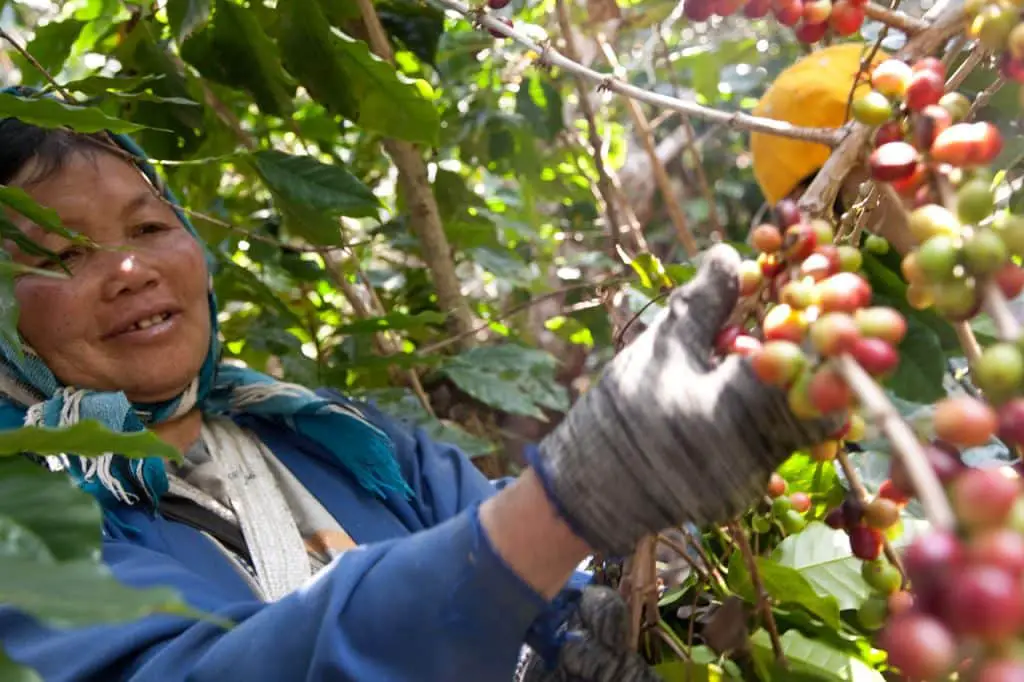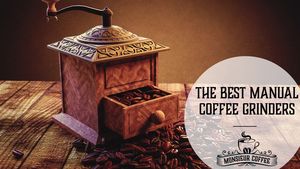
Best Automatic Coffee Grinders in 2022
Grinding your coffee right before you brew it is probably the best thing you can do to improve the quality of the coffee you make.
To be honest, it doesn’t keep me up at night. But the question of whether coffee is man-made has fuelled quite a few late-night (and alcohol-induced) discussions with friends over the past years.
Let’s see if we can untangle this puzzle. Shall we?
But, for the TLDR (and to please the search engine Gods), let’s start with the answer:
Is coffee man-made? No, coffee is a natural product. Coffee beans are the seeds of the coffee cherry, which grows on the coffee plant (Coffea Arabica). Man-made usually refers to artificial things.
While the production of coffee from cherry to roasted bean is a process that involves a lot of steps (as illustrated below) – and definitively needs human interaction – the bean itself is the result of a natural process.
But as easy and quick as this answer might seem. There is more to it.
In the rest of this article, I explore the invention of coffee, and I give (a short and woefully incomplete) an overview of the coffee production process.

Unfortunately, who exactly invented the coffee (as in the drink) is shrouded in mystery. The most famous legend told whenever you read about the history of coffee is that of Kaldi.
The tale goes that Kaldi was a goat herder in the Ethiopian highlands who lived around 850 AD. This goat herder noticed that whenever his goats ate the berries from a particular tree, they became very active and wouldn’t go to sleep at night.
After chewing on the berries himself, he found that he too became very energetic. He brought his discovery to an Islamic monk who lived in a local Sufi zawiya (a place similar to a Christian monastery).
The tale tells that the monk disapproved of these berries as stimulants, and he threw them in the fire. The burning berries (and the roasting beans inside) gave off such a pleasant smell that someone raked them out of the fire.
The beans were then supposedly ground up and put into hot water. Et voila… the world’s first cup of coffee.
To me, this story sounds pretty far-fetched. And historians have said that the story is probably apocryphal (i.e., begin of doubtful origin, but widely believed to be true).
Anyhow, we do know for certain that the coffee plant (specifically, the Coffea Arabica) has its origins in the Ethiopian highlands. However, by the 16th century, the coffee plant was cultivated, grown, and traded all across the Arabian peninsula.
We know for a fact that coffee was grown in the area that we know today as Yemen. We also know that people bought, sold, and drank coffee in Iran (then known as Persia), Iraq, Egypt, Syria, and Turkey.
By the 17th century, coffee had reached Europe.
So, we don’t for a fact know who invented coffee. But, we know that coffee originates from the Ethiopian highlands. It was probably first made in a Sufi monastery (a zawiya) in the 15th century.
So, coffee beans come from a plant that grows berries we call cherries. Coffee beans are the seeds of this coffee cherry.
Does that mean coffee beans are actually a fruit? Maybe, but that’s a different question, which is answered in this article.
But do you go from cherries and their seeds to a hot steaming cup of joe? Part of the question of whether coffee is man-made lies in explaining what goes into turning coffee plant cherries into the ground coffee you put in your Mr. Coffee.
In the section below, you’ll find a (very short) general overview of the coffee production process. As you’ll see, the production of coffee is a very involved process. There is no way coffee (as in the beverage) or coffee beans (the roasted kind that produces said beverage) can develop from something untouched by humans. I’d say that makes a case for coffee being man-made.
The first step is harvesting the coffee cherries at their peak ripeness.
The picking of only the perfectly ripe cherries (when they have turned from green to a deep red color) is an extremely labor-intensive process. Pickers need to pass each tree every eight to ten days in the harvesting season and pick the perfectly ripe cherries.
Naturally, this only happens on plantations that produce high-quality arabica coffee beans for the specialty coffee scene.
For the coffee that you typically find in the isles of the supermarket, harvesting is a far more industrialized process.
This more industrialized coffee cherry harvesting method is called strip picking. All coffee cherries are picked at the same time, regardless of their ripeness.
Although this is a far more efficient and less labor-intensive method, it negatively impacts the final product.
When the coffee has been harvested, the seeds (let’s call them beans from now on) must be separated from the fruit pulp.
There are a few methods for this, which can be divided into three categories: wet processing, dry processing, and semi-dry processing.
Before drying the coffee beans (i.e., the seeds of the coffee cherry), the fruit covering the beans needs to be removed. The wet coffee processing method (also called washed coffee for apparent reasons) uses special machinery and a considerable amount of water to do this.
After sorting, the coffee cherries are immersed in water. This step separates the good from the bad. The bad (or unripe) coffee cherries will float, while the good (ripe) will sink to the bottom of the tub.
The coffee cherries are pushed through a screen with a hole just larger than a coffee bean in the next step. This removed the skin and most of the pulp.
The rest of the fruit pulp is removed by various methods, depending on the location and size of the processing plant.
The classic method to remove the remaining pulp in the wet process is the so-called ferment-and-wash method. The pulp is broken down by allowing the pulp-covered beans to ferment with the addition of microbes.
Fermenting breaks down the pectin (or cellulose) in fruit pulp, making the pulp even pulpier.
The beans are then washed to remove the broken-down pulp.
The dry process is the original coffee processing method. After picking the coffee, cherries are first sorted to filter out any bad or unripe cherries.
Then the cherries are cleaned and placed in the sun on drying racks.
During the 4 (!) weeks it might take to dry the cherries to an optimal level, the coffee is raked through or turned multiple times each day to ensure even drying and to prevent the development of mildew.
Dry processed coffee beans are also known as unwashed or natural coffee beans.
There is bound to be a hybrid of the two when there is a dry process and a wet process. Enter: semi-dry processing.
This involves removing the skin of the coffee cherry in a pulping machine, leaving it (coated in fruit pulp) for a day, and then the pulp is washed off.
This method of processing results in coffee beans that are said to be higher in acidity and have an increased body.
You’ll also find these coffee beans labeled as wet-hulled, semi-washed, or pulped natural.
After the skin and pulp of the coffee cherry have been removed, you are left with a very wet green coffee bean covered in a paper-thin silvery skin.
In the case of dry-processed coffee beans, you are left with a complete dried-out cherry.
Coffee beans processed through the wet or semi-dry process are left to dry (dry-processed cherries are already dried) to the optimal moisture level (between 10% and 12%) either in the sun or in a drying machine.
Hulling removes any leftover fruit pulp and skin.
Polishing removes the silvery skin, also called (what’s in a name) silver skin.
Finally, the dry green coffee beans are cleaned and sorted for storage. This is usually done by machines that remove any leftover sticks or stones, or other kinds of debris.
The coffee beans are also (usually) tested for density and size, and color.
Coffee beans are then stored in a big bag of either jute or woven poly. Storage can either mean storage before transportation or just storage. G
reen coffee beans are usable for several years after harvesting.
The main takeaway here is that coffee is stored and transported in an unroasted state. After roasting, coffee is only good for a couple of weeks.
At least, that’s the case if you ask the average barista. However, the big coffee manufacturers will have you believe that roasted and even ground coffee has a shelf life of months, if not years.
We have taken a look at the invention of coffee, and we have glanced at the production process of coffee.
While coffee is, in essence, a natural product, there is no denying that human intervention is crucial. Let’s put it this way: without nature, there is no coffee cherry, but without a human, that coffee cherry will never turn into a roasted coffee bean, let alone a cup of coffee.
So the case for coffee being man-made is a strong one. But If you look at the dictionary, you’ll find that man-made usually means “artificial.” And artificial means that something is not naturally produced or grown.
Complicated… But there is a solution!
Coffee is both!
It is both man-made and natural.
Ah… ever the diplomat.
But seriously, if you would ask a linguist, they would definitely not call coffee man-made. The foundations of your cup of coffee are easily traced back to the natural product.
Let’s settle this…
Coffee is not man-made.
MonsieurCoffee.com is a participant in the Amazon Services LLC Associates Program, an affiliate advertising program designed to provide a means for sites to earn advertising fees by advertising and linking to Amazon.com. We earn small commissions on purchase made through links on this site, at no extra costs to you.
Click Here to See How

Grinding your coffee right before you brew it is probably the best thing you can do to improve the quality of the coffee you make.

Grinding your own coffee is the best thing you can do to improve the quality of the coffee you make and drink. But should you

Butter Coffee is all the rage right now. It is a drink made with coffee (duh!), butter (preferably grass-fed), and a thingy called medium-chain triglycerides

I hope you drink coffee because you love the taste of it. But chances are you also drink coffee for a little wake me up